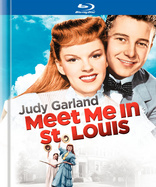Meet Me in St. Louis Blu-ray Movie
HomeMeet Me in St. Louis Blu-ray Movie 
Blu-ray + CDWarner Bros. | 1944 | 113 min | Not rated | Dec 13, 2011
Movie rating
7.7 | / 10 |
Blu-ray rating
| Users | 4.8 | |
| Reviewer | 4.5 | |
| Overall | 4.5 |
Overview
Meet Me in St. Louis (1944)
The well-off Smith family has four beautiful daughters. Seventeen-year-old Esther has fallen in love with John, who has just moved in next door. He however, barely notices her at first. The family is shocked when Mr. Smith reveals that he has been transferred to a nice position in New York, which means that the family has to leave St. Louis and the 1903 St. Louis Fair.
Starring: Judy Garland, Margaret O'Brien (I), Mary Astor, Lucille Bremer, Leon AmesDirector: Vincente Minnelli
| Romance | Uncertain |
| Musical | Uncertain |
| Family | Uncertain |
Specifications
Video
Video codec: MPEG-4 AVC
Video resolution: 1080p
Aspect ratio: 1.36:1
Original aspect ratio: 1.37:1
Audio
English: DTS-HD Master Audio 5.1 (48kHz, 24-bit)
French: Dolby Digital Mono
Spanish: Dolby Digital Mono
Subtitles
English SDH, French, Spanish
Discs
50GB Blu-ray Disc
Two-disc set (1 BD, 1 CD)
Playback
Region free
Review
Rating summary
| Movie | 4.5 | |
| Video | 4.5 | |
| Audio | 4.5 | |
| Extras | 4.0 | |
| Overall | 4.5 |
Meet Me in St. Louis Blu-ray Movie Review
Have Yourself a Merry Little Blu-ray.
Reviewed by Jeffrey Kauffman December 7, 2011It’s no big secret that Judy Garland did not want to do Meet Me in St. Louis. She saw it as yet another film in which she was going to play a young girl without much dramatic range, and furthermore this film had a role for a very young girl (the role of Tootie which ultimately helped Margaret O’Brien win a Juvenile Academy Award) that was apt to draw focus from Judy herself. It took quite a bit of convincing from several people who were involved in the pre-production of the film, but what it may have boiled down to was a simple request Judy made of director Vincente Minnelli. She wanted to look beautiful. Garland had always been self conscious about her appearance and especially her weight, which M-G-M studio honcho Louis B. Mayer repeatedly complained about, leading to Garland’s lifelong problems with amphetamines, which the studio regularly supplied her to help keep her appropriately svelte. Judy’s calling card had always been her voice, of course, but walking around a studio lot that had some of the most glamorous females in the film industry only added to her insecurity. It didn’t take much convincing for Minnelli to agree, as he seemed almost preternaturally smitten by Garland, and of course the two would soon marry, albeit for a relatively brief and tempestuous union. But in many ways Meet Me in St. Louis is Vincente Minnelli’s love letter to Judy Garland, and though the film really has next to no dramatic arc (as Liza Minnelli humorously recounts in her introduction, much to Louis B. Mayer’s chagrin), the film is like a picture postcard time travel portal to a more winsome, innocent age, when families gathered around the parlor upright to sing popular songs of the day, and a threatened move away from the only home the family had ever known was the cause for major emotional upheaval. The fact is, there probably never was a St. Louis like the one depicted in the film, and there may indeed may never have been a family like the Smiths of Meet Me in St. Louis, but that’s part of the nostalgia, forced or otherwise, that has made this film such an outstanding favorite for so long.
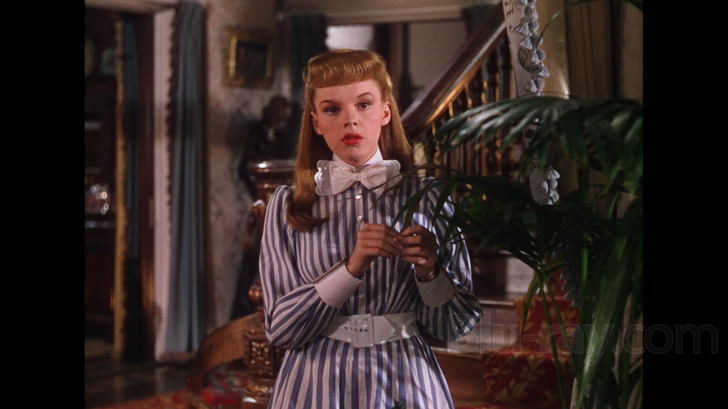
Younger audiences raised on the quick cutting, manic approach of such latter day film musicals as Chicago may well find Meet Me in St. Louis positively stultifying. We’re introduced to the large Smith family, including daughters Esther (Garland), Tootie (O’Brien), Rose (Lucille Bremer), and Agnes (Joan Carroll), as well as lone son Lon (Henry H. Daniels, Jr.). The Smith parents are Alonzo (Leon Ames) and Anna (Mary Astor), and the crusty family maid is Katie (Marjorie Main). The film opens in 1903, when St. Louis still (at least in this film version) had dirt lanes lining its spacious residential neighborhoods and things like the daily milk delivery were made by men on horse drawn carts. The placid day to day life is at least partially upended by two events. Esther has fallen for the new boy who has moved in next door, John Truitt (Tom Drake), though John doesn’t seem to notice Esther even exists. And out of the blue Mr. Smith announces that he’s been transferred to New York City and the family will have to move from its comfortable life in St. Louis. That’s basically all there is to the “dramatic arc” of Meet Me in St. Louis, and for modern day audiences, that frankly may not be enough to maintain interest in the ADHD environment in which a lot of current day movies play out.
What Meet Me in St. Louis offers instead is charm in abundance, as well as some of the most touching “little” moments in that era of musical film. Hugh Martin and Ralph Blane contributed three original songs to the score (which otherwise consists of period tunes that were popular in the early twentieth century), all three of which have become standards, “The Boy Next Door,” “Have Yourself a Merry Little Christmas,” and the song which took home the Oscar that year, “The Trolley Song.” Meet Me in St. Louis is an uncommonly integrated film musical for its day, and as Liza Minnelli points out in her introduction, the first song, the old chestnut title tune, is actually introduced by characters just kind of singing as they go about their daily business around the Smith household. But it’s the Martin-Blane contributions that are probably the best remembered musical elements of the film, and in fact Minnelli crafted the whole iconic trolley sequence simply due to the song.
There are a couple of interesting trivia bits with regard to Meet Me in St. Louis’s song score. First of all, careful listeners will notice some interesting differences in the lyric to “Have Yourself a Merry Little Christmas” from the version with which they’re probably most familiar. The song is actually much more bittersweet in the film, as Esther tries to help Tootie come to terms with the fact this will be their last holiday in St. Louis. When Frank Sinatra wanted to record the song, he didn’t want it to be so morose, and so Martin and Blane recrafted it into the version that has become a standard around the holidays. In a somewhat weirder piece of trivia, Meet Me in St. Louis had been in development for a long time around M-G-M (as the fascinating commentary gets into, there were four completed versions of the script by the time the film really went into high gear, and the only reason it was prioritized for completion is that M-G-M’s lease of a then very rare Technicolor camera was due to expire). One of the many people who had drifted through the pre-production process was none other than Oscar Hammerstein II (of Rodgers and Hammerstein fame). M-G-M had purchased rights to a song that had been cut from Oklahoma! called “Boys and Girls Like You and Me,” and that song was initially supposed to come directly after “The Trolley Song” sequence. Unfortunately, much as it had been in the stage musical, the song was once again cut from Meet Me in St. Louis, but its ignominy didn’t end there. The song was repeatedly cut from subsequent properties, and ultimately was shoehorned into the stage version of the Rodgers and Hammerstein television musical adaptation of Cinderella.
As charming as Meet Me in St. Louis undeniably is, it’s also undeniable that with so many hands in its creation it does occasionally show some of its seams. With little dramatic impetus to move the story along, the film is one of the more anecdotal musicals of its era, and that may make the film less palatable to some. There’s little suspense here and the romantic angle is such a foregone conclusion that the film never musters up much conflict to stand in the way. The finale also is too tellingly a riff on Judy’s inconic “There’s no place like home” mantra from the end of The Wizard of Oz. Still and all, Meet Me in St. Louis is a deliciously tranquil step through a probably imaginary and overly rosy-glassed view of what life was like in the first few years of the twentieth century. But that’s what The Dream Factory was all about, wasn’t it?—dreaming.
Meet Me in St. Louis Blu-ray Movie, Video Quality 
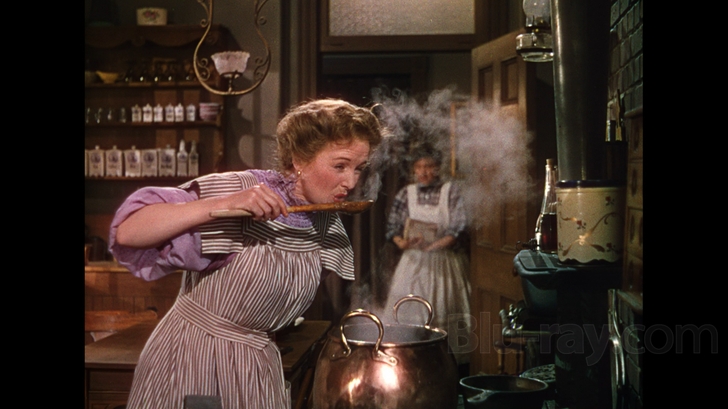
Meet Me in St. Louis is presented on Blu-ray courtesy of Warner Brothers Home Entertainment with an AVC encoded 1080p transfer in 1.36:1. Once again Warner has treated an M-G-M catalog title with the respect which it deserves, and this is a sumptuous and gloriously cinematic experience. Fine grain detail is still intact without being noisy, and that absolutely gorgeous Technicolor palette is reproduced to a tee. The bright crimson reds and blues of the women's dresses pop magnificently, but even supposedly drabber colors like the brown dungarees the Chill Wills character wears look beautifully saturated. The overall image is suitably sharp, though be aware that Minnelli deliberately filmed Garland in soft focus quite a bit of the time—this is not a transfer issue. Contrast and black levels are both exceptional and no egregious damage of any kind was noticed.
Meet Me in St. Louis Blu-ray Movie, Audio Quality 
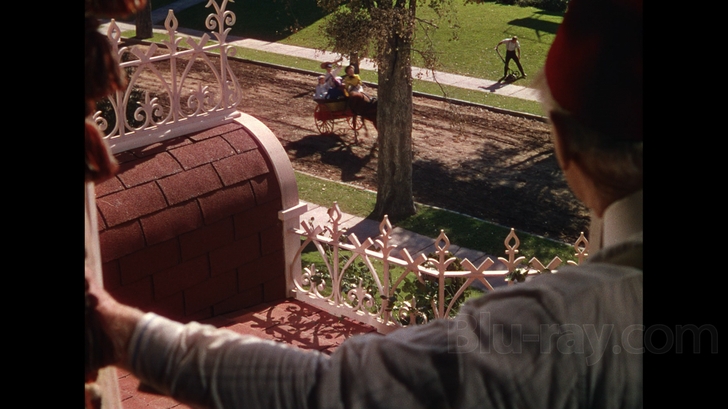
Meet Me in St. Louis has been fitted with a lossless DTS-HD Master Audio 5.1 repurposing, but the good news is that no overly gimmicky faux surround activity has been attempted here. Most of the surround activity is relegated to the charming song score, while dialogue and effects are resolutely anchored in the front channels (as they should be). While there's still just the hint of boxiness in the track, due no doubt to the original recording conditions and the condition of the stems utilized here, the lossless track opens things up rather considerably, so that more highs and lows of Conrad Salinger's elegant orchestrations can be more clearly heard. Fidelity is quite good and natural sounding, with no damage and relatively little age-related hiss. The midrange is especially fulsome here, bring out the full luster of Garland's glorious voice.
Meet Me in St. Louis Blu-ray Movie, Special Features and Extras 

- Commentary by John Fricke, Margaret O'Brien, Irving Brecher, Hugh Martin and Barbara Freed-Saltzman. This unusually excellent and informative commentary is hosted by John Fricke, who wrote one of the best biographies of Garland, and features a wealth of background data on the production from virtually every imaginable angle. There's a lot of heartfelt reminiscing from O'Brien (who has a very funny anecdote about her mother spiriting her off to Morocco after Louis B. Mayer refused a pay increase) and Hugh Martin, who reveals some surprising information about his collaboration with Ralph Blane.
- Introduction by Liza Minnelli (SD; 4:59). This is also a very heartfelt piece, albeit short, as Liza recounts some background on the film where her parents met each other.
- Meet Me in St. Louis: The Making of an American Classic (SD; 30:47) is a nice overview of the film, and includes some snippets of Judy's CBS variety show where she performed the three Martin-Blane songs from the film.
- Hollywood: The Dream Factory (SD; 50:31) is a great 1972 M-G-M documentary detailing some of Hollywood's greatest films, musicals and non-musicals, narrated by Dick Cavett.
- Becoming Attractions: Judy Garland (SD; 46:10) is a Robert Osborne hosted TCM special which looks back over Garland's storied career courtesy of trailers for her films.
- Meet Me in St. Louis 1966 TV Pilot (SD; 26:35). This never made it to air, but is a sweet little prospective series with Shelley Fabares, Celeste Holm, and Wesley Addy (Holm's husband).
- Bubbles (SD; 7:54) is a fantastic 1930 Warner Brothers Vitaphone short featuring a very young Judy Garland (still part of The Gumm Sisters).
- Skip to My Lou (SD; 3:11) is a 1941 Soundie short with Hugh Martin and Ralph Blane.
- Audio Vault contains "Boys and Girls Like You and Me" Outtake; 12/2/1946 Lux Radio Theater Broadcast; and a Music Only Track.
- Theatrical Trailer (SD; 1:42) is actually a reissue trailer.
- CD Sampler includes the three Martin-Blane originals from the score as well as Garland and Bremer performing the title song.
- Digibook Packaging includes a wealth of photographs along with some frankly fairly useless text.
Meet Me in St. Louis Blu-ray Movie, Overall Score and Recommendation 
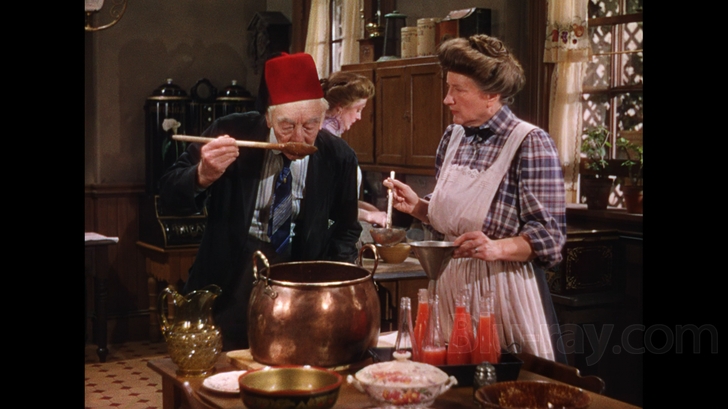
Meet Me in St. Louis is rather strangely routinely passed over when most people think of holiday movies, but it is in fact one of the most quietly heartwarming films of its era and makes perfect Christmas fare, especially with the elegant (if rather sad in this version) "Have Yourself a Merry Little Christmas" one of the film's highlights. But this is really a film for the ages, and for all seasons (as the film's framing conceit so admirably proves), one which may not be bombastic even in the slightest but which charms effortlessly with its deliberately small story. Warner has done a bang up job on this release with stellar video and audio quality. Highly recommended.
Similar titles
Similar titles you might also like

An American in Paris
1951

Easter Parade
1948

A Star Is Born
1954

The Band Wagon
1953

Hello, Dolly!
Fox Studio Classics
1969

The Broadway Melody
Warner Archive Collection
1929

The Music Man
1962

My Fair Lady 4K
BD is Bonus Features
1964

Guys and Dolls
Warner Archive Collection
1955

On the Town
1949

Brigadoon
1954

South Pacific
50th Anniversary Edition
1958

Summer Stock
Warner Archive Collection
1950

Lullaby of Broadway
Warner Archive Collection
1951

Fiddler on the Roof
1971

The King and I
1956

Rent
2005

Singin' in the Rain 4K
70th Anniversary Edition
1952

The Last Five Years
2014

Oklahoma! - Platinum Edition
1955
